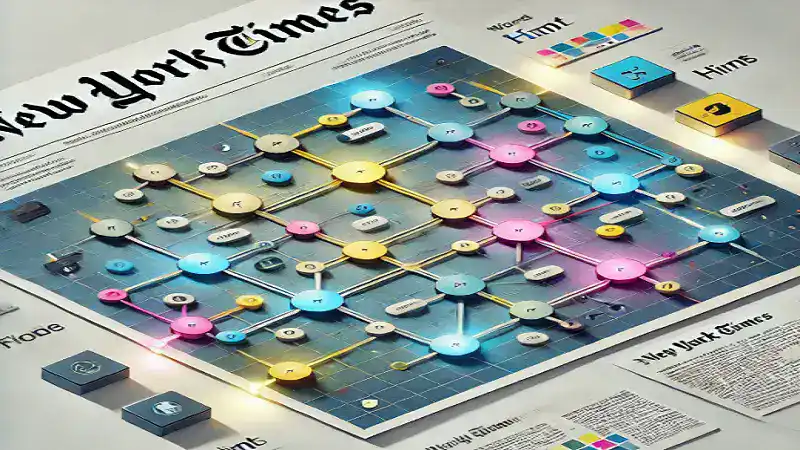The NY Times Connections puzzle is one of the most popular and engaging daily word challenges online. Many players enjoy the thrill of solving the puzzle and testing their vocabulary skills. Each day brings a new set of words, and the objective is to categorize them into groups based on common themes. It might sound simple, but it can be tricky sometimes, especially when stuck on a difficult set of words.
In this article, we’ll provide you with valuable NY Times Connections hints today, practical tips for solving the puzzle efficiently, and how to boost your chances of completing it without too much frustration. Whether you’re a seasoned player or a newcomer, these strategies will help you level up your puzzle-solving game.
What Is NY Times Connections?
The NY Times Connections puzzle is a daily word game where you’re given a set of 16 words, and your goal is to sort them into four groups of four words based on common themes. These themes can be anything from categories like animals, colors, historical figures, types of food, and more.
Each word in the puzzle is meant to fit into a specific category. Some words may seem tricky and could fit into multiple categories, so you’ll need to think critically and consider all possibilities. Solving the puzzle is both a fun and challenging way to test your knowledge and cognitive skills.
How to Approach the NY Times Connections Puzzle
Here are some practical tips and strategies that can help you solve the NY Times Connections puzzle more efficiently:
1. Look for Obvious Categories First
One of the easiest ways to start solving the puzzle is by identifying the most obvious categories. Often, the words in the puzzle will have clear connections that are easy to spot. For example:
- Animals: Words like “dog,” “cat,” “elephant,” or “fish” may fit into an animal-related category.
- Colors: Words like “red,” “blue,” “green,” and “yellow” may indicate a color group.
Once you identify one or two categories, you can rule out some of the words and narrow down the remaining ones. This helps reduce the complexity of the puzzle.
2. Group by Shared Characteristics
If you can’t immediately spot an obvious category, try grouping words by shared characteristics. Some common characteristics to look for include:
- Types of Food: Look for ingredients, spices, or food-related terms (e.g., “tomato,” “lettuce,” “pasta,” “olive”).
- Geographical Locations: Words that refer to cities, countries, or continents can be grouped together (e.g., “Paris,” “Tokyo,” “Brazil,” “Australia”).
- Periods or Historical Events: Certain words might hint at historical themes (e.g., “WWII,” “Renaissance,” “Ancient Rome,” “Medieval”).
This method can help you narrow down categories more effectively, even when the connections are not immediately obvious.
3. Consider Different Meanings of Words
Some words in the NY Times Connections puzzle might have multiple meanings or can be used in different contexts. For example:
- The word “light” could refer to a color, a physical property, or even a weight.
- “Match” could be a sports event, a device for lighting fires, or a pairing of similar items.
By considering the different meanings or uses of each word, you can open up additional categories. Think about the multiple definitions of words and see if they could fit into different themes.
4. Eliminate Impossible Groupings
If you’re stuck, don’t hesitate to eliminate words that don’t belong together. For example, if you know a word belongs to one category (say, “animals”), but it doesn’t make sense in the context of another category (such as “countries”), this will help you rule out possible connections. By process of elimination, you can progressively narrow down your options.
5. Look for Hidden Connections
Sometimes the connection between words may not be immediately obvious and might require a more creative approach. For example, you might have a set of words that are related through a common attribute like:
- Phrases or Idioms: Words that are commonly found in a specific phrase or idiom (e.g., “raining cats and dogs,” “a bird in the hand”).
- Pop Culture References: Words tied to movies, books, or songs can form unique categories (e.g., “Hogwarts,” “Voldemort,” “Hermione,” “Wand”).
Be prepared to think outside the box and consider more abstract connections.
Tips for Finding the Best NY Times Connections Hints Today
If you want to boost your chances of completing the NY Times Connections puzzle, here are some practical tips you can use to improve your puzzle-solving skills and find the best hints for the day:
1. Use a Process of Elimination
As you solve the puzzle, cross out the words that are already grouped correctly. By eliminating words that belong to specific categories, you can focus on the remaining words and try to identify connections more easily. This helps simplify the puzzle and speeds up the process.
2. Don’t Overthink It
At times, you might get stuck overanalyzing the words. Try not to overthink the connections or force a fit if something feels off. Sometimes the solution is simple and doesn’t require extensive analysis. Go with your gut feeling and trust your instincts.
3. Take Breaks and Return with Fresh Eyes
If you’ve been struggling for a while and feel like you’re stuck, step away from the puzzle for a few minutes. A short break can give you fresh eyes and allow you to spot connections you might have missed initially. Sometimes, taking a moment to reset helps unlock the solution.
4. Consult External Resources
If you’re truly stumped, some external resources and communities can provide hints for NY Times Connections today. These can include:
- Online forums and puzzle-solving communities: Websites like Reddit often have discussions where users share their hints and solutions.
- Puzzle guides: Some websites offer detailed breakdowns of the daily puzzles, helping players learn different strategies.
However, be mindful of not relying too heavily on these resources, as the fun of the game lies in solving the puzzle yourself.
5. Practice Daily
The more you play the NY Times Connections puzzle, the better you’ll get at spotting patterns and identifying potential categories. Regular practice will help you develop a sharper eye for connections and allow you to solve the puzzle faster each day.
How to Improve Your Puzzle-Solving Skills
To truly master the NY Times Connections puzzle, you’ll need consistent practice and patience. Here are a few steps you can take to improve your skills:
- Play Other Word Games: Engaging in other word games like Wordle, Crossword Puzzles, or Scrabble can help enhance your vocabulary and thinking skills.
- Study Word Categories: Familiarize yourself with common categories like sports, food, geography, pop culture, and historical events.
- Read and Learn: A broad knowledge base helps you spot patterns in the puzzle. Reading books, articles, and even trivia can provide you with valuable context for solving tricky word connections.
Conclusion
The NY Times Connections puzzle can be challenging, but with the right strategies and consistent practice, you can develop the skills necessary to solve it with ease. By using techniques like looking for obvious categories, eliminating impossible groupings, and thinking creatively about word meanings, you can improve your puzzle-solving abilities.
Learn more Connection Hints


